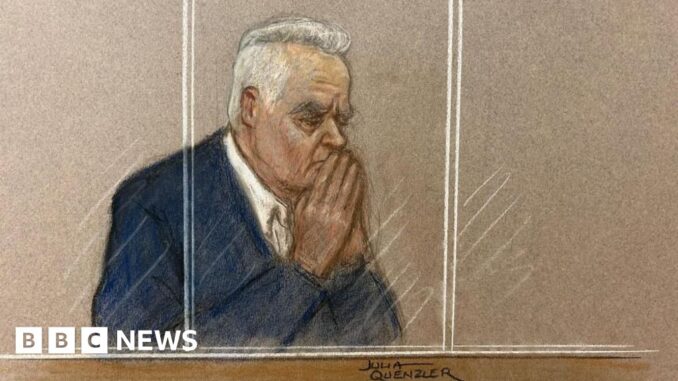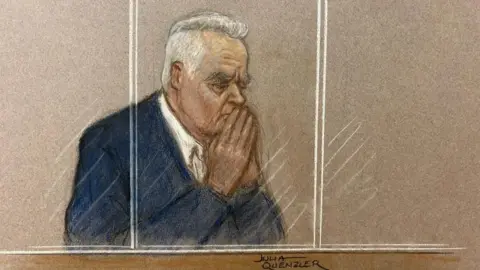
 Julia Quenzler
Julia QuenzlerFormer BBC News presenter Huw Edwards has been given a suspended prison term after he admitted making indecent images of children. Westminster Magistrates’ Court heard he received more than 40 images over several months from convicted sex offender Alex Williams. Here are four things we learned from the sentencing hearing.
Online exchanges lasted about four years
When Huw Edwards pleaded guilty in July, we knew that he had communicated with Alex Williams, the man who supplied the indecent images, from at the very least December 2020.
That’s when Williams, convicted earlier this year, sent Edwards the first images that count as “indecent”, the archaic legalese for depictions of abuse.
The online relationship in fact began two years before that and it was of a sexual nature. According to the evidence, it coincided with a period when Edwards was struggling with both his mental health and sexual identity.
Williams said he had contacted Edwards because he was hoping to get a response.
He did – and the online relationship lasted four years on and off – and Edwards began receiving legal pornographic images and a smaller number of illegal abuse images.
Prosecutor Ian Hope told the sentencing hearing they met once in person, and there was an evidence of a solitary video-call too.
The only evidence of this relationship comes from Williams’s phone as the handset used by Edwards at the time was not found.
Payments – but not for images
The bulk of the 377 images were legal pornography featuring young adult men. But 41 of them depicted children.
Edwards would have been aware of what he was being sent, because he discussed it with Williams.
“In December 2020 Alex Williams said that he had ‘a file of vids and pics for you of someone special’,” prosecutor Ian Hope told the court.
“Mr Edwards immediately queried who the subject was and was then sent three images of seemingly the same person.”
That person was aged between 14 and 16 and the images were “Category C” in the table of severity of abuse, the lowest of the three tiers.
Williams then asked Edwards whether he wanted the “full file”.
Edwards responded: “Yes xxx…”
Williams then sent further and more severe images of abuse and a final video file of a Category A incident involving abuse of a boy aged between 13 and 15. Edwards and Williams wished each other a Happy Christmas.
When Williams said he had “hot” files that were big to send, Edwards recommended Dropbox. In time, the former newsreader referred to some of the material as “amazing” but it is not clear whether that meant the legal or illegal images.
We heard in court that Edwards had paid Williams. But this was not taken by the sentencing chief magistrate to mean that he had been paid for the indecent images. It was more a case of “thank you” for whatever was going on between them – in effect gifts.
For instance, Williams asked for “a Christmas gift after all the hot videos”.
Edwards sent him £200 for some Nike Air Force 1 trainers.
And in total, Williams received between £1,000 and £1,500, which helped pay his way at university.
This on and off exchange continued through to 2021. Edwards ultimately received seven files of the worst type of abuse.
There’s no evidence as to what Edwards thought about those files – but a crucial part of the case shows that he did respond to questions Williams asked him about the subject matter. That shows that it was Williams who was leading the conversation about the nature of the images, rather than Edwards.
“Is the stuff I’m sending too young for you?” asked Williams on 19 February 2021. Three days later Edwards replies: “Don’t send underage.”
But when in August Williams offered Edwards more files, and said they involve people who were “yng”, the former newsreader said: “Go on.” This was the second of two videos featuring a child aged between seven and nine.
Prosecutor Ian Hope said: “Alex Williams says the subject is ‘quite yng looking’ to which Mr Edwards responds it ‘can be deceptive’ and asks if he has ‘any more?’ Alex Williams says he has but he is not sure if Mr Edwards would like them as they are illegal. Mr Edwards says ‘Ah ok don’t’.”
 PA Media
PA MediaMental health battles
The evidence in the case shows that Edwards had been struggling with mental ill health for many years and had fragile self-esteem. The court heard he had what appears to have been unresolved feelings about his sexuality dating back to 1994.
Confusion about sexuality is not the same as an interest in images of child abuse – far from it. So what led to him receiving the images from Williams, even if he later regretted it?
A forensic psychotherapist wrote in a report for the court that the people Edwards was meeting via social media helped boost his low mood – but then created a “perfect storm” leading to the offending.
That decision making, the court heard, was linked to Edwards’ mental ill health and the wider picture of his complex character.
One expert who analysed Edwards said he grew up in a puritanical but hypocritical environment with a father described in court as “monstrous”. Edwards entered adulthood feeling inferior – and that was compounded, the expert concluded, by working in an organisation that he had perceived as being full of Oxford graduates (Note to readers: it isn’t).
In time he developed clinical depression leading to therapy at times – but his situation worsened from 2018 – and then more so during the first awful year of the pandemic, which coincides with the majority of the offending. The conclusion of the experts was that Edwards was sufficiently unwell that it affected his decision-making – a situation exacerbated by alcohol, a heart problem and a breakdown of relationships within his own family.
All of this could sound to some like a sob story – but the court accepted that there was evidence that Edwards’ mental health had improved – and therefore his understanding of his crimes – thanks to help. And that sign of improvement was a key factor in what the chief magistrate decided to do.
Sentencing can be a very finely balanced act
The burning question for many tonight is why was Huw Edwards not sent to prison? The simple answer is … there is no simple and uniform solution for dealing with offenders.
The offence he committed could in theory lead to 10 years in jail.
But, in practice, detailed sentencing guidelines, developed over years of comparing varying cases, save that severe punishment for the worst of the worst people who are producing the images that Williams scooped up and went on to share.
Edwards, by receiving them, was at the bottom of that chain of abuse.
So his sentence was always going to be well short of that maximum 10 years – and, likely to be shorter than the 12 months suspended sentence given to Alex Williams in March.
The guidelines say that for someone in Edwards’ position, the starting point is a year in jail with a range of between six months and three years.
Chief Magistrate Paul Goldspring began his sentencing calculation with a year. He knocked three months off to take into account the mental health evidence and the fact that this was a first offence. This is absolutely standard procedure.
He then discounted the sentence by a third, bringing it down to six months, to credit the earliest possible guilty plea.
Again, this discount for an admission is a standard feature of sentencing law. It is an offer to focus an offender’s mind on pleading guilty early and accepting their crimes.
It saves a huge amount of public money by not tying up the criminal justice system with a jury trial. And it means, if the offender is willing, they can get on with the long and hard process of rehabilitation as soon as possible.
The next question was whether Edwards needed to be jailed to protect the public. The chief magistrate concluded not, because he accepted evidence that the offender before him had already understood the gravity of what he had done – and was responding to therapy.
And so he moved down a notch from immediate jail to a suspended six month sentence. That means that if Edwards were to commit another offence in the next two years, he would be likely to go to jail immediately. But if he stays on the road to reform, he won’t.
The prosecution had argued that Edwards needed to be subject to restrictions on his liberties through a Sexual Harm Prevention Order. That would have allowed agencies to monitor or curtail his communications and movements – including knowing his entire internet history on every device he uses.
The court heard that probation experts had used a “predictor tool” to estimate the likelihood of Edwards reoffending. It had found his risk of indirect internet-based offending – meaning viewing more images – to be medium.
But his lawyers argued that risk was diminishing because he was on the mend and had shown genuine remorse.
The chief magistrate said that it was not necessary to subject Edwards to the additional SHPO conditions, given the progress towards rehabilitation already underway.
Edwards must complete a 40-day Sex Offender Treatment Programme and 25 rehabilitation sessions aimed at helping him to fix his mental health and use of alcohol.
Even if all that is successful, there is a sting in the sentencing tail.
For the next seven years Edwards will be on the sex offender register – meaning he has to keep the police informed of his whereabouts. It will be difficult for him to travel abroad on holiday and some countries may never let him in at all.
He’s free from prison – but he is not free in the true sense of the word. His life choices will be watched on and off for years to come.



Be the first to comment